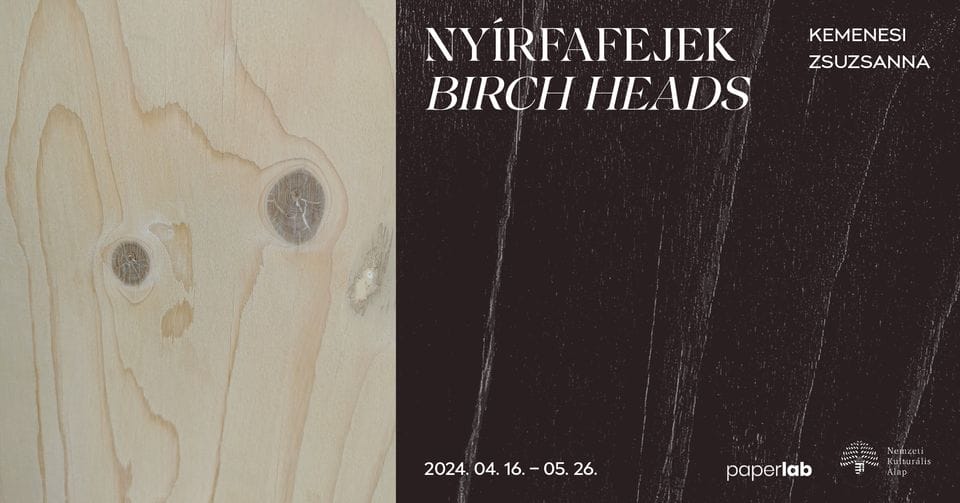
Kemenesi Zsuzsanna: Nyírfafejek
April 16 - May 27

KEMENESI ZSUZSANNA: NYÍRFAFEJEK
A kiállítás ingyenesen megtekinthető:
2024. április 16. – május 26.
Keddtől vasárnapig 12 és 19 óra között.
Hétfőn és ünnepnapokon zárva.
Kurátor: Baki Péter
Sorsok, arcok, temperamentumok: emberek, akik a legfinomabb eszközökkel élnek a legdurvább sors ellen. S egy szalmaszállal védenek ki viharokat.
A lét minden lehetőségével, térrel és idővel léteznek, mély bölcsességgel és üde mámorossággal, könnyedséggel.
A kulturális tapasztalatok és gyakorlatok sokfélesége a vizualitásban is sokféleséghez vezet. Azt vizsgálom, hogy milyen formák alakultak ki a történeti fejlődés során a világ különböző régióiban, a kultúrák találkozása, keveredése, cseréje során.
Ahol valamely társadalom modernizálódik, ott a portréábrázolás modernizációja is megjelenik.
A modernizáció, a modernitás, a modern társadalom ugyanis globális és nem csupán európai jelenség. A kultúrák hasonlóságai, eltéréseik távolságaik vizsgálatai nem merülhetnek ki abban, hogy a nem nyugati társadalmak modernitásait a nyugati modernitás tükrében értelmezzük. A feladatomnak tekintem, hogy a társadalom- és kultúratudományi kutatásokon alapulva a vizuális nyelvezet változását is lekövessem, tanulmányozzam. A modern társadalom globális, regionális és lokális megragadása a célom.
A modernizáció lefolyása legyen bármilyen hirtelen, drámai vagy gyökeres, a portréábrázolásban létező kulturális, művészeti és vallási hagyományokat teljes egészében nem tudja azonnal megváltoztatni. S habár ezek a jelenségek, tudások és koncepciók maguk is állandóan változnak, mégis alkalmazkodnak egy sor globálisan terjedő eszméhez és gyakorlathoz. Ezen tudásformák reprezentálják azt a történeti kontinuitást, amihez a modernitás eszméinek és gyakorlatának alkalmazkodnia kell. A modernizáció átírja, illetve újraírja a társadalmak közötti különbségeket, hagyományokat: azaz, a régi különbségekből új különbségek születnek.
Egy példával élve, nézzük meg a középkori felfogást, amely a társadalmat három részre osztotta: az oratores, a bellatores, és a laboratores rendjeire – azokra, akik imádkoznak, akik harcolnak, és akik dolgoznak. A papság imádkozott a világi emberekért, a világi emberek pedig védelmezték a papságot. Ez esetben teljesen világos, hogy a morális rend, több mint csupán normák összessége. A gondolatok cseréje, amelynek során, amikor csak lehetséges közmegegyezésig jutunk el. A hierachikus komplementaritás összes pompájával, rituáléjával és képvilágával.
„Jót és jól – ez az ars poeticám” – vallja Kemenesi Zsuzsanna fotográfus, kommunikáció kutató, aki egyetemi docensként 2004 és 2017 között vizuális kommunikációt és fotóesztétikát tanított a Kaposvári Egyetem Fotóművészeti karán. A Pécsi Tudományegyetem Kommunikáció- és Médiatudományi Tanszékén vendégtanár volt. Kemenesi 1999 és 2002 között Pécsi József Fotóművészeti ösztöndíjas, 1996-tól pedig egy éven át volt Jáva szigetén az Art Institute of Indonesia, Yogyakarta Média Kar Fotográfia szakának ösztöndíjas hallgatója. 1994-ben Londonban tanult és 2000-ben egy rezidencia program keretében Salzburgban alkotott. 2005-ben a Magyar Fotóművészek Szövetségének elnökségi tagjává választották. PhD tanulmányait a Kommunikációs Doktori Program keretén belül 2000 és 2008 között folytatta Budapesten.
Első egyéni kiállításán az Infranesia című sorozatát Jakartában állították ki a Gallery TC-ben 1997-ben, majd egy évvel később Magyarországon a Mai Manó Házban került bemutatásra ez az anyag. Kemenesi alkotói folyamatait Kerekes Gábor, Herendi Péter és Barta Zsolt Péter inspirálta, munkáival ázsiai, amerikai és európai kiállításokon találkozhatunk.
Önálló albumai és könyvei: Magánbeszéd (Városháza Kiadó 2000); Christopher Rauschenberg (szöveg) – Kemenesi Zsuzsanna (fotó): Sweet as Cherry, Fine like Wine (Magyar Fotóművészek Szövetsége 2008); Fotókalligráfiáktól a titkosírásokig (GlobeEdit 2019).
https://www.maimano.hu/programok/kiallitas-kemenesi-zsuzsanna-nyirfafejek
ZSUZSANNA KEMENESI: BIRCH HEADS
The exhibition is free to visit
between 16 April and 26 May 2024
Tuesday to Sunday, from 12 a.m. to 7 p.m.
Closed on Mondays and public holidays.
Curator: Péter Baki
Fates, faces, temperaments: people who use the most subtle means to fight the harshest fates. They ward off storms with a straw.
They avail themselves of all the possibilities of existence, space and time, with profound wisdom and exhilaration, with lightness.
The diversity of cultural experiences and practices also leads to diversity in visuality. I examine the forms that have emerged in the course of historical development in different regions of the world, through the encounter, mixture and exchange of cultures.
Wherever a society is modernizing, portraiture also undergoes modernization. That is because modernization, modernity, modern society are global phenomena, and are not exclusive to Europe. Examining the similarities of cultures, their differences and distances cannot be limited to interpreting the modernities of non-Western societies in the light of Western modernity. I consider it my task to trace and study the changes in visual language based on the findings of the social and cultural sciences. I seek to capture modern society globally, regionally and locally.
However sudden, dramatic or radical, the course of modernization cannot immediately change the entirety of the cultural, artistic and religious traditions of portraiture. And although these phenomena, forms of knowledge and concepts are themselves constantly changing, they are adapting to a set of globally prevailing ideas and practices. These forms of knowledge represent the historical continuity to which the ideas and practices of modernity must adapt. Modernization overwrites or rewrites the differences between societies, the traditions: put differently, the old differences give rise to new differences.
For an example, take the medieval, tripartite concept of society, in which it comprises of three orders: the oratores, the bellatores, and the laboratores—those who pray, those who fight, and those who work. The priesthood prayed for the lay people, and the lay people defended the priesthood. In this case, it is quite clear that the moral order is more than just a set of norms. An exchange of ideas, reaching a common understanding whenever possible. With all the pomp, ritual and imagery of hierarchic complementarity.
‘Do something good and do it well—that is my artistic credo,’ says Zsuzsanna Kemenesi, photographer and communication scientist, who taught visual communication as a guest lecturer at the Communication and Media Studies Programme of the University of Pécs between 2004 and 2017, and was also an associate professor at the Faculty of Photography at the University of Kaposvár. Kemenesi was a Pécsi József Photography Fellow between 1999 and 2002, and from 1996, she was a scholarship student at the Photography Programme of the Faculty of Media at the Art Institute of Indonesia, Yogyakarta, Java for one year. She studied in London in 1994, and in 2000 she was an artist-in-residence in Salzburg. In 2005, she was elected into the board of the Association of Hungarian Photographers. She pursued her PhD studies in Budapest between 2000 and 2008 at the Doctoral Programme in Communication.
In 1997, at her first solo exhibition, she presented the Infranesia series in Jakarta’s Gallery TC, and went on to show the same set in Hungary the next year, at the Mai Manó House. Kemenesi’s creative process has been inspired by Gábor Kerekes, Péter Herendi and Zsolt Péter Barta, and she exhibits her works in Asia, the US and Europe.
Her solo albums and books include Magánbeszéd (Private Talk, Városháza Kiadó 2000); Sweet as Cherry, Fine like Wine (Magyar Fotóművészek Szövetsége 2008), with text by Christopher Rauschenberg; and Fotókalligráfiáktól a titkosírásokig (From Photo Calligraphy to Cryptography, GlobeEdit 2019).
https://www.maimano.hu/programs/exhibition-zsuzsanna-kemenesi-birch-heads
https://www.facebook.com/events/847532143854395/



